Home Energy Efficiency Programmes Scotland: annual review 2016-2017
A review of how the Warmer Homes Scotland Scheme has performed and made progress towards meeting the scheme's stated objectives.
Part 2: Objective 1 - Fuel poverty
The first stated objective of Warmer Homes Scotland is to reduce fuel poverty by reducing the heating costs of vulnerable households. Traditionally, in Scotland we have defined a household as fuel poor if, in order to maintain a satisfactory heating regime, it would be required to spend more than 10% of its income on all household fuel use. Warmer Homes Scotland uses proxies to identify those households that are fuel poor with the qualifying criteria based on factors that indicate the likelihood of a household being in fuel poverty such as age, income and disability.
Following recommendations from the Scottish Fuel Poverty Strategic Working Group and Rural Fuel Poverty Taskforce, in early 2017 Scottish Ministers appointed an independent panel of experts to review the existing definition of fuel poverty, to ensure that help is being targeted to those who need it most.
The Definition Review Panel reported in November 2017. To coincide with this report the Scottish Government published a consultation on a new fuel poverty strategy, including a proposed new definition of fuel poverty that was informed by the Panel’s work. The consultation closed on 1 February 2018, and responses to it will inform policy development and the Warm Homes Bill that is to be introduced to the Scottish Parliament in 2018.
Evidence suggesting that existing support schemes are making a positive impact includes the 2016 Scottish Housing Condition Survey. This concludes that around one third of the reduction in households living in fuel poverty in Scotland can be attributed to improvements in the energy efficiency performance of the housing stock.
i. Eligibility
This review examined the two main aspects of the eligibility criteria in order to:
a. ensure that the criteria correctly identify fuel poor households; and
b. determine if households that can be considered to be in fuel poverty do not meet the qualifying criteria for the scheme.
The charts below show the customers who were referred to Warmer Homes Scotland, broken down by the primary benefit they were in receipt of at the time of qualifying for the scheme, and by age.
Figure 3 shows that the top three qualifying criteria for the scheme, in terms of volume, remain the same as in the 2015/16 operating year. The largest group of customers qualify for Warmer Homes Scotland based on their entitlement to Disability Living Allowance ( DLA) or Personal Independence Payment ( PIP) followed by those households supporting a child under 16 and in receipt of a qualifying benefit. The third largest group of customers are those over the age of 75 in receipt of a qualifying benefit.
Figure 3: Primary Benefits of customers referred to Warmer Homes Scotland
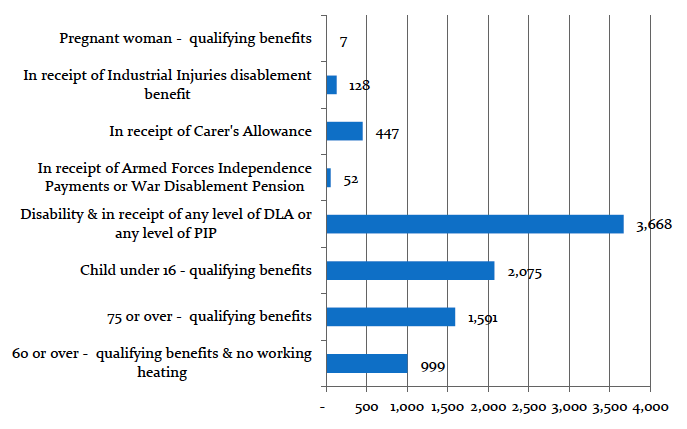
Figure 4: Age Profile of Warmer Homes Scotland Customers
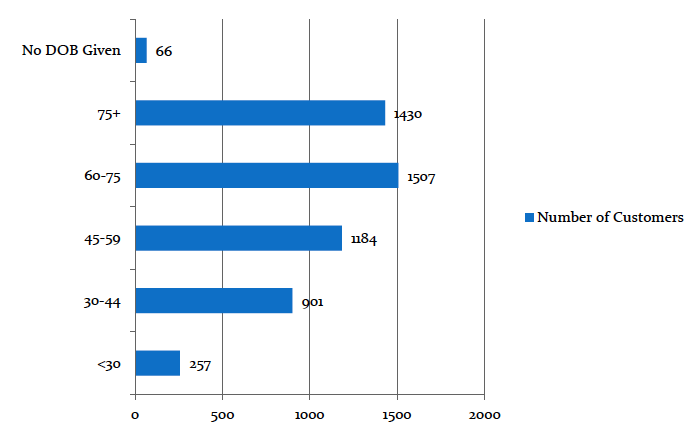
The 2016 Scottish Housing Conditions survey outlines the key features of the fuel poor population in Scotland in 2016. Its findings showed that, of the households living in fuel poverty, around 10% are families with children, 48% are older one or two person households and 42% are other types of households with adult residents. In relation to housing tenure 58% of fuel poor households are owner-occupiers, 31% are social housing residents and 11% private sector tenants. This survey also showed that fuel poverty has a strong association with income and households with lower incomes have the highest rates of fuel poverty. 87% of households with an income of less than £200 per week were fuel poor compared to only 3% of those households with an income of over £700 per week. These are the highest and lowest income bands used in the survey.
Given that Warmer Homes Scotland uses proxies to identify those households that are most likely to be living in or at risk of living in fuel poverty and when compared to the findings of the Scottish Housing Condition Survey 2016, the information in Figure 3 shows that the scheme is supporting those households that are likely to be living in or at risk of living in fuel poverty. The households with the largest uptake of the scheme are those that have a member who has a disability, which is used as a proxy for a low-income household, and the households who are supporting young children or an elderly person aged 75 or over. This supports the use of proxies in identifying those households who are at most risk of living in fuel poverty. However, as DLA and PIP are not means-tested benefits it cannot be concluded that Warmer Homes Scotland is supporting only low-income households. Having said this it must be noted that customers in receipt of DLA may also be in receipt of other income-related benefits, as Home Energy Scotland only records the primary qualifying benefit of customers referred to the scheme.
The figures for the tenure types for Warmer Homes Scotland show that the majority of customers (81.5%) with completed installations are owner- occupiers. This may reflect the help given to social housing tenants through other fuel poverty schemes and the landlord’s obligations under the Repairing Standard that places a duty on to landlords in the Private Rental sector to ensure that heating in their properties is in good working order and a reasonable state of repair.
Table 1: Warmer Home Scotland completed installations by tenure type
| Owner-occupied | % of Total | Rented (private) | % of Total | Total | |
|---|---|---|---|---|---|
| 15-16 Budget Year | 1159 | 83.5 | 213 | 15.5 | 1372 |
| 16-17 Budget Year | 4329 | 81 | 1025 | 19 | 5354 |
| Total | 5488 | 81.5 | 1238 | 18.5 | 6726 |
Therefore, whilst the current eligibility criteria appear to capture households at risk of fuel poverty, these households might not strictly adhere to the definition of fuel poverty that specifically refers to income. Furthermore, there may be low-income households living in fuel poverty who currently do not qualify for Warmer Homes Scotland because they are not in receipt of one of the qualifying benefits.
While opening up the eligibility criteria to enable more households to access Warmer Homes Scotland would increase the likelihood of capturing fuel poor households, the number of households that the scheme can help is limited by the budget. Even without extending the criteria, demand for the scheme in 2016/17 exceeded the available budget. Additional funding was identified and the budget was increased from £19 million to £25 million and this allowed more than 1,000 additional households to benefit from the scheme.
Recommendation 1 - In light of the changes to the fuel poverty definition, review the eligibility criteria to ensure Warmer Homes Scotland continues to meet its stated objective to reduce fuel poverty.
Table 2 shows that, for the review period, 828 applications were cancelled post-referral because they did not meet the eligibility criteria. The vast majority of these (nearly 90%) were due either to the SAP rating of the house being too high to qualify, or that there were no suitable measures identified for the property.
Following the 2015/16 Annual Review of Warmer Homes Scotland, the qualifying SAP threshold was increased from 55 to 65. The total number of households that did not qualify post-referral due to the SAP rating being too high increased from 357 in 2015/16 to 393 in 2017/18. However, due to the total number of referrals increasing significantly in the same period, this equates to a significant fall in percentage terms from 26% in 2015/16 to 7.3% in 2016/17. Further investigations into the reasons why the customers whose property has a SAP rating greater than 65 were referred would be required to establish if this number could be further reduced.
The suitability of available measures is examined in more detail in Part 4 of this review.
Table 2: Reasons Customers did not Qualify Post Referral
| Reason | Number | % of Total |
|---|---|---|
| Applicant Less than 1 Year at Property | 55 | 6.7 |
| Applicant Not of Eligible Age and No Eligible Children | 3 | 0.4 |
| Applicant Not on Benefits | 31 | 3.6 |
| Applicant Proofs Missing | 7 | 0.9 |
| Commercial property | 1 | 0.1 |
| Multi-occupancy property | 1 | 0.1 |
| Property Housing Association/(Council Tenant) | 7 | 0.9 |
| SAP - Too high | 393 | 47.5 |
| SAP Qualifies but no suitable measures | 329 | 39.7 |
| Unknown | 1 | 0.1 |
| Total | 828 | 100 |
Recommendation 2 - Carry out an in-depth analysis of the reasons why applications that do not qualify post-referral are being referred to Warmer Homes Scotland and make recommendations as to how these numbers can be reduced.
It is accepted that households in remote and rural areas not connected to the gas grid have higher fuel costs than those households connected to the gas grid and those in urban areas. Consequently, under the current definition households in remote or rural areas are more likely to be in fuel poverty [2] . Therefore, it would be expected that the uptake of Warmer Homes Scotland would be proportionately greater in these areas. Figure 5 shows a map of Warmer Homes Scotland installations in 2016/17 and Figure 6 shows maps of postcodes with a gas supply.
Table 3: Number of completed installations by region
| Region | Population (mid 2016) | Installs per 1,000 People |
|---|---|---|
| Islands | 71,950 | 3.36 |
| Highlands | 321,900 | 1.81 |
| North East | 1,003,570 | 0.90 |
| South West | 520,080 | 1.13 |
| South East | 1,364,860 | 0.76 |
| Strathclyde and Central | 2,122,340 | 0.93 |
| Scotland Average | 5,404,700 | 0.99 |
From our analysis of installations under Warmer Homes Scotland in 2016/17, uptake per head of population was greater in rural areas than in urban areas. The scheme is designed to ensure people in rural areas have equal access to the same measures despite the higher costs of installing these measures in remote and rural areas. From Table 3 we can see that installs per 1,000 of the population was over three times the national average in the Islands region, and almost twice the national average in the Highlands region.
Recommendation 3 - To identify if there are any noticeable changes in rates or anomalies by region or year, the 2017/18 review should carry out a trend analysis of rates of fuel poverty by region and analyse this when compared to Warmer Homes Scotland installations data from launch in 2015 to end of Year 3.
Figure 5: Map of Warmworks Installations in 2016/17
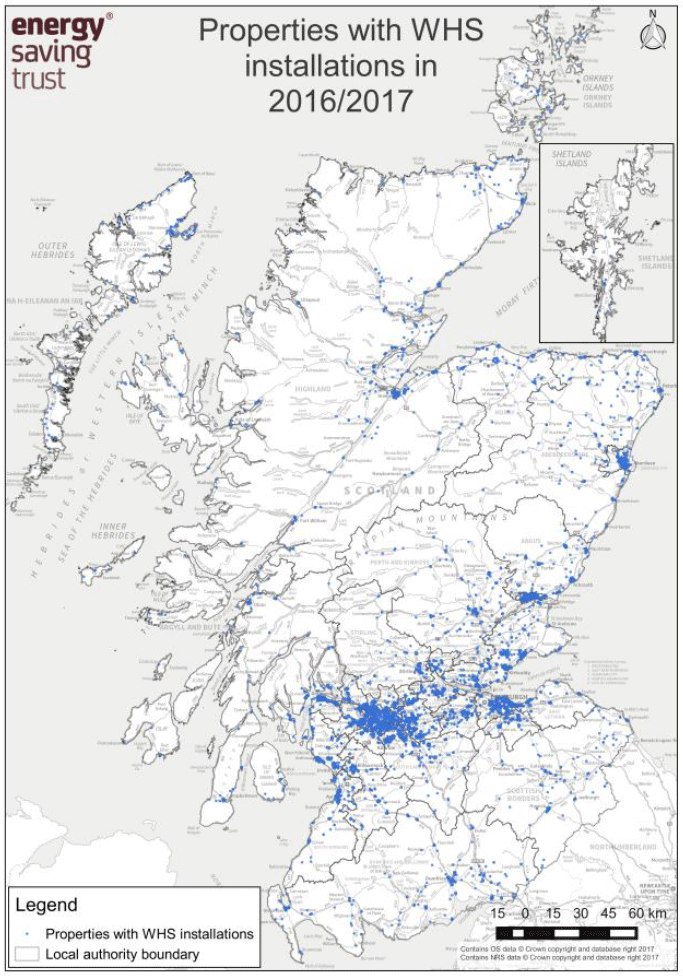
Figure 6: Map of Postcodes with Gas Supply
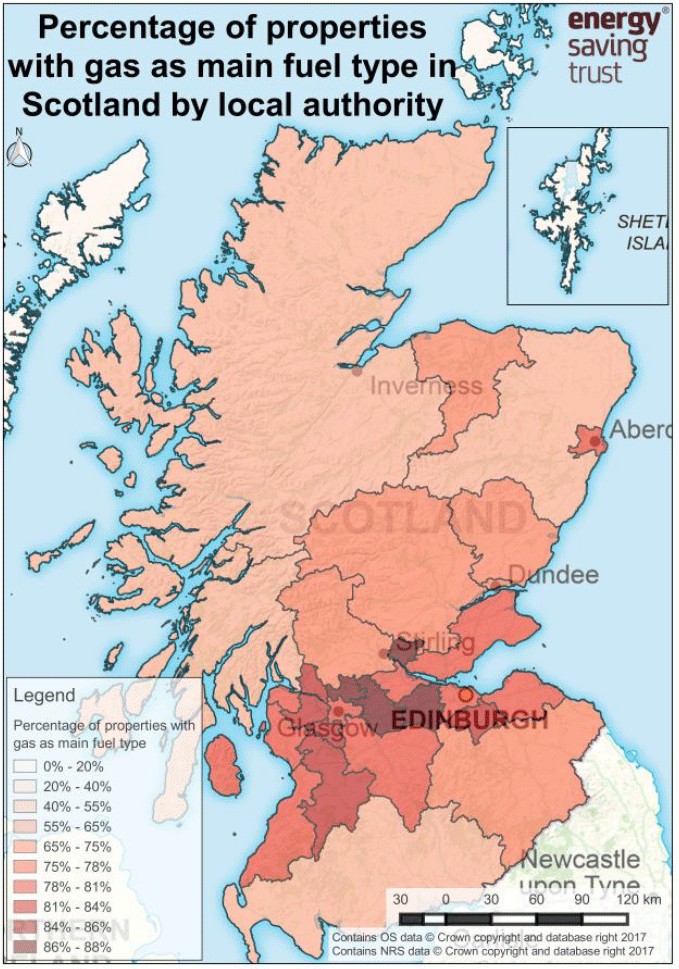
ii. Awareness
Awareness of Warmer Homes Scotland is important as a way to ensure that the scheme reaches fuel poor households, and to ensure that fuel poor households are aware of the benefits of having measures installed under the scheme. Considering the breakdown by receipt of benefits and age in Figure 3, it appears that those in receipt of Carer’s Allowance, Industrial Injuries Disablement Benefit, War Disablement Pension, Armed Forces Independence Payment, and pregnant women have the lowest uptake of the scheme. From Figure 4 we can see that this is also true for those under the age of 30. There are no figures available for the percentage of the population who are in receipt of these benefits in Scotland so it is impossible to compare this group of Warmer Homes Scotland customers to the general population. The same is true for those households with all members under 30 who are living in fuel poverty.
Figure 7: Number of calls (weekly) to HES compared to Warmer Homes Scotland Referrals and the linear trends
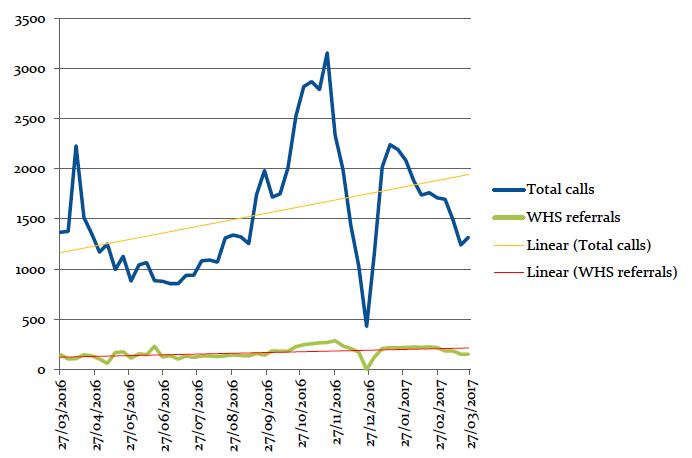
Despite the fluctuations in calls to the HES helpline, as shown in Figure 7, the average number of referrals to Warmer Homes Scotland remained relatively constant throughout 2016/17. However, the trend for numbers of referrals increased throughout 2016/17.
Figure 8 shows Warmer Homes Scotland referral levels in more details. The average number of monthly Warmer Homes Scotland referrals remained steady throughout the period. Home Energy Scotland contacted all those customers who had previously failed to qualify for the scheme due to the SAP rating of their property being too high and this corresponds to the peak in Warmer Homes Scotland referrals at the beginning of June when the change to the eligibility criteria was made. The upward trend for the numbers of referrals throughout this period is reflected in the upward trend in the call volumes to the HES helpline.
Figure 8: Graph showing the average number of weekly referrals and the trend for referrals to Warmer Homes Scotland in 2016/17
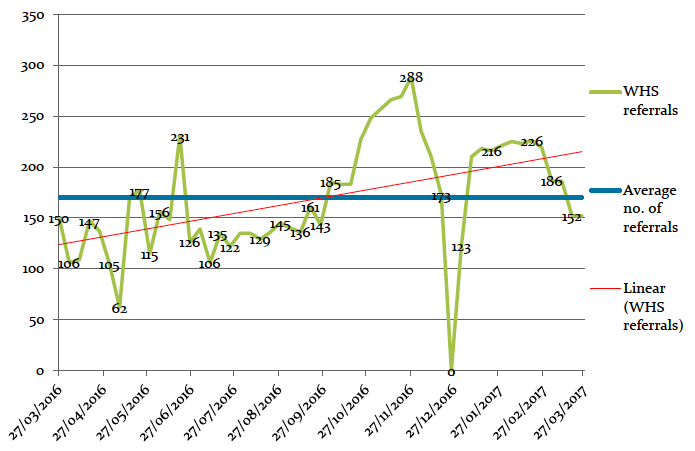
A marketing campaign was carried out by Home Energy Scotland in autumn 2016. This began with TV, Radio and Online adverts in September 2016 and a direct mailing exercise in November. The campaign focused on all available support from Home Energy Scotland, and did not focus specifically on Warmer Homes Scotland. This marketing campaign created an uplift of over 1000 calls per week to HES over the campaign, resulting in an increase in Warmer Homes Scotland referrals.
iii. Attractiveness
The third element of accessibility of Warmer Homes Scotland is attractiveness. This can be further broken down into two strands:
a. encouraging a customer to take up a referral to Warmworks; and
b. ensuring that once referred, they want to remain in the process
Once a customer has contacted Home Energy Scotland, gone through the initial screening process and is deemed eligible for Warmer Homes Scotland, they are referred to Warmworks and have a home survey booked. On receiving a referral to the scheme, Warmworks takes over the management of the end-to-end customer journey that is shown at Figure 9. The customer journey process had remained substantively the same since Warmer Homes Scotland was launched in September 2015.
During 2016 some elements of the customer journey were reviewed. This resulted in changes being made to the contract to include additional pause periods that allow more time for customers to have the necessary finance, support and documentation from landlords in place and any new or replacement fuel tanks installed. These additional pause periods were incorporated in to the contract with the agreement of a CVN in March 2017.
Figure 9: Warmworks Customer Journey
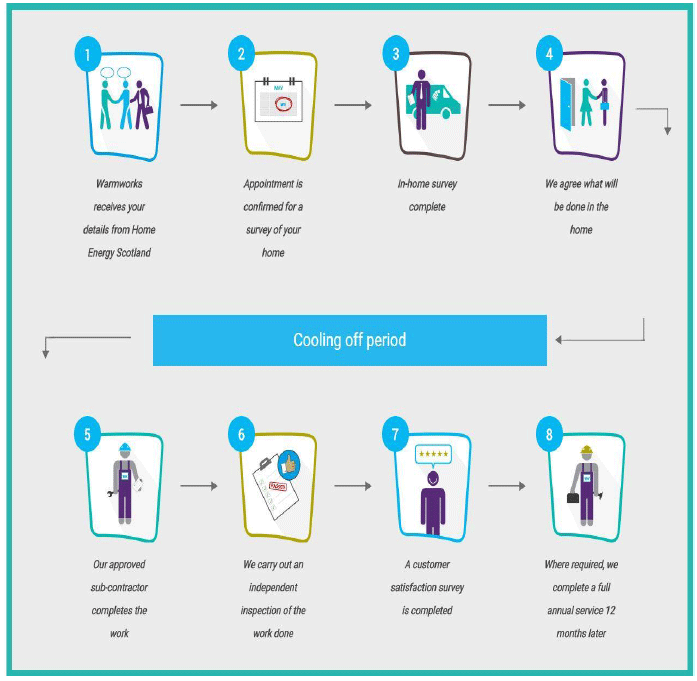
In the first 5 months of operation of the Warmer Home Scotland contract a KPI “holiday” was in operation whereby no financial penalty was applied when the KPIs were not met. This affected the cancellation rates as fewer applications were being cancelled by Warmworks.
In 2016/17 a total of 2019 customers cancelled their application to Warmer Homes Scotland. While this is a marked increase on the actual number of cancellations from 2015/16, proportionately this was a decrease from 65% of completed households in 2015/16 to 38% of completed households in 2016/17.
Table 4: Reasons customers cancelled their Warmer Homes Scotland application
| Cancellation reason | Number of Cancellations 15/16 | % of Cancellations 15/16 | Number of Cancellations 16/17 | % of Cancellations 16/17 |
|---|---|---|---|---|
| Applicant - Due to Contribution | 37 | 4.1 | 36 | 1.8 |
| Applicant Cancelled - Upheaval/Preparation works required | 130 | 14.5 | 311 | 15.4 |
| Applicant Deceased | 12 | 1.3 | 13 | 0.6 |
| Applicant Illness | 35 | 3.9 | 92 | 4.6 |
| Applicant Moving House | 20 | 2.2 | 44 | 2.2 |
| Applicant No Longer Interested (Fuel/Measure Choice) | 151 | 16.9 | 488 | 24 |
| Applicant Not Able To Proceed At This Time | 72 | 8.1 | 16 | 0.8 |
| Applicant Not Interested (Other) | 7 | 0.8 | 16 | 0.8 |
| Applicant out-with timescales | 67 | 7.5 | 578 | 28.6 |
| Applicant Private Install | 41 | 4.6 | 57 | 2.8 |
| Asbestos | 6 | 0.7 | 4 | 0.2 |
| Duplication | 65 | 7.3 | 52 | 2.6 |
| LLP (Landlord refused Works or No Contact) | 24 | 2.7 | 135 | 6.9 |
| No Access (Survey) | 16 | 1.8 | 23 | 1.1 |
| Unable to Contact | 133 | 14.9 | 150 | 7.4 |
| Unknown | 78 | 8.7 | 4 | 0.2 |
| Total | 894 | 2019 |
As shown by Table 4, the most common reason for cancelled applications is that they were out-with the timescales of the process. Following the 2015/16 Annual Review, the contract was amended by means of a CVN in March 2017 to add five additional categories of “allowed Pause Periods” were agreed with the intention of reducing the number of applications cancelled because they were out-with the Referral to Completion ( RTC) timescale. This change was implemented too late to have an impact on the 2016/17 figures and the percentage of applications cancelled for this reason increased from 7.5% in 2015/16 to 28.6% in 2016/17.
The second most common cause of cancellations is that the customer is no longer interested due to the fuel or measures recommended at the initial survey. This group has decreased from 16.9% of cancellations in 2015/16 to 15.4% of cancellations in 2016/17.
The third most common reason for cancellations is the perceived upheaval and/or the need for preparation works. As a proportion of applications, this has increased by 0.9% from 2015/16. This small increase has occurred despite the additional leveraging of financial support into the scheme to support customers with enabling measures that Warmworks have achieved in 2016/17. This additional support is discussed in full in Part 5 of this report that looks at how the scheme delivers value for money.
Figure 10, shows Warmworks’ customer satisfaction scores against volume of survey returns in 2016/17. Customer satisfaction for those customers who remain in the process is very high with 98.5% of customers satisfied or very satisfied by the overall service received. This is based on a 76.4% return rate for completed customer satisfaction surveys. This high customer satisfaction rating indicates that customers are generally happy with the levels of service they receive from Warmworks throughout their customer journey.
The total number of complaints received by Warmworks in 2016/17 was 165 and Pennington Choices confirmed this during the audit process. This amounts to 3% of all completed installations carried out under Warmer Homes Scotland. The number of complaints upheld was 87, which is 1.5% of completed installations and 52% of complaints received. This reinforces the high customer satisfaction rating received by Warmworks during 2016/17.
Figure 10: Customer Satisfaction Scores
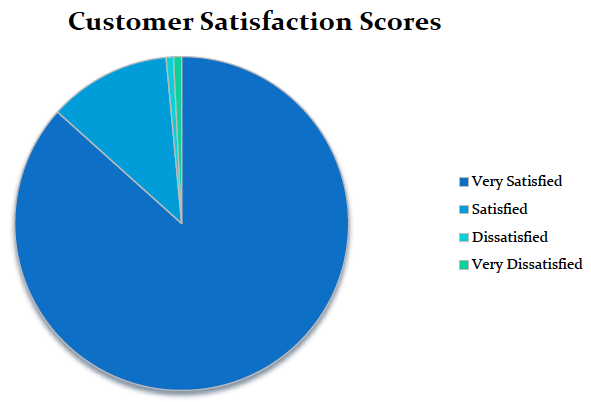
The evidence presented suggests that Warmer Homes Scotland is an attractive option for customers. However, more may need to be done to ensure eligible customers take up the offer of support after they have been referred to the scheme.
Recommendation 4 - Continue to monitor cancellations rates to identify any emerging trends and use lessons learned from other related projects to make any necessary improvements in managing the Warmer Homes Scotland customer journey.
Contact
There is a problem
Thanks for your feedback